Culture of Reunion Island
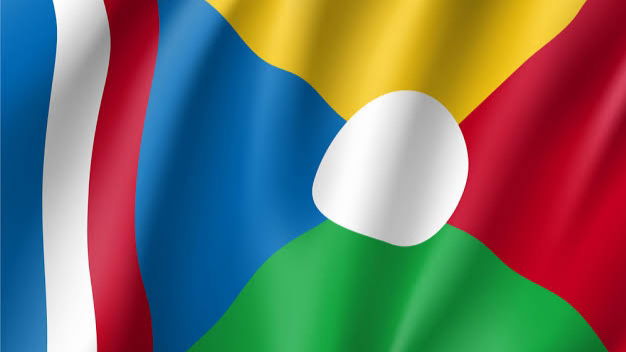
Culture Name
Reunion Islander
Orientation
Identification. Reunion Island (in French, La Reunion ) is a multicultural society composed of people originally from France, Mozambique, India, China, Madagascar, and the Comores. Islanders use their ethnic origins to define themselves as Cafres (African ancestry) Z'oreilles (born in mainland France), malabars or Tamouls (from Tamil Nadu southern India), Z'arabes (from Gujarat in northern India), Chinois (from China), Malgaches (from Madagascar), Comores (from Comores), Petits blancs (poor rural whites living in the highlands), or Creoles blancs (white landowners). The term Creole today also applies to people with a mixed ethnic background. All the residents of the island are administratively French citizens.
Location and Geography. Reunion Island lies in the Indian Ocean, off the eastern coast of Madagascar. At 970 square miles, (2,512 square kilometers), it is the largest of the Mascarene islands. High plains separate two volcanic systems. Climatic variations range from humid to dry tropical to Mediterranean. More than half the land is not suitable for cultivation. Periodic cyclones can be devastating. The capital is Saint Denis.
Demography. In 1999, the population was over 717,000. It is difficult to categorize the population by ethnic background, but estimates indicate that approximately twenty percent of the population is of Indian ancestry, and around five percent is born in mainland France.
Linguistic Affiliation. Although French is the official language, Creole is the language of everyday life. Based on French, with a mixture of Malagasy and Tamil words, it is used with relatives and for informal interactions. French is generally used in formal situations. Although everybody understands it, many people cannot speak it; therefore, its use is a marker of educational achievement and social status.
Symbolism. Economic and cultural ties are almost exclusively with mainland France; Reunion is officially called "the France of the Indian Ocean." Since the development of tourism in the 1970s, the image the island tries to project to the outside world is that of a multicolored society where people with different ethnic backgrounds live together peacefully.
History and Ethnic Relations
Emergence of the Nation. Discovered at the beginning of the sixteenth century, the island was reached by the French in 1643. Reunion (then called Mascarin ) was devoid of inhabitants. The French sent twelve convicts into exile there. In 1649 they officially claimed the island in the name of the king and named it Bourbon . Colonization started in 1665, when the French East India Company sent the first twenty settlers. After 1715, settlers produced coffee and spices, which ultimately were replaced by sugarcane. In 1792, France renamed the island La Reunion.
The labor force needed on the sugarcane plantations was supplied by slaves from Mozambique and Madagascar. At the end of the seventeenth century, the population could be divided into white French landowners and African and Malagasy slaves. A great number of white settlers arrived too late to gain access to the land and, excluded from the plantation system, retired in the highlands, where they constituted a poor white population ( Petits blancs ).
The abolition of slavery in 1848 led white landowners to recruit indentured laborers for their plantations, particularly Tamils. Most Tamils stayed at the end of their five-year contracts and continued to work for the white landowners. At the turn of the century, some Chinese and Muslim Gujaratis arrived
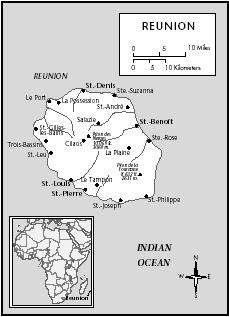
Reunion
to sell food and textiles. In 1946, Reunion became one of the four overseas department of France, and it became an administrative region in 1974.
Having lost their cultural links with their societies of origin, African and Maslagasy slaves were subject to deculturation and pauperization. By contrast, whites, Chinese, Muslim Gujaratis, Tamils, and French from the mainland have been able to maintain most of their original systems of value while adapting it to the local context.
National Identity. Since the beginning of immigration, the French government has stressed assimilation of the populations under its control, exploiting the resources of the island while pressuring immigrants to become "French." As a result, all members of this multicultural society are officially "French citizens." However, many descendants of Tamil immigrants have maintained their ancestral beliefs and patterns of behavior. Although Chinese residents were also converted to Christianity, they are less westernized than are residents of south Indian ancestry. Most still speak Chinese and have kept links with relatives in China. Gujaratis Muslims also have been able to preserve their culture and religion.
Ethnic Relations. Whites and people of African, Tamil, and mixed ancestry consider themselves the original inhabitants of the island, in contrast to Gujaratis and Chinese. However, all native residents feel a strong difference between themselves and people from mainland France. The French, who generally do not stay more than three or four years on the island, are rarely considered full members of the society. Both populations live close to each other but inhabit different cultural worlds.
Food and Economy
Basic Economy. The economy was traditionally based on agriculture. During the eighteenth and nineteenth centuries, the most important crops were coffee and cloves and then sugarcane.
Major Industries. The labor force consists of workers in services (seventy-three percent), industry (nineteen percent), and agriculture (eight percent). Major industries include sugar, rum, handicrafts, and flower oil extraction.
Trade. The major exports are sugar, rum vanilla, and perfume essences. Imported commodities include manufactured goods, food, beverages, tobacco, raw materials, machinery and transportation equipment, and petroleum products. The economy depends on financial assistance from mainland France, which is also the principal trading partner. Around 100,000 people born in Reunion work and live in mainland France. Massive importation of goods has led to a large deficit in the balance of trade. The government has promoted tourism to reduce unemployment, which affects more than a third of the labor force.
Social Stratification
Classes and Castes. The transformation of Reunion into a French department slowly substituted a pseudo-industrial and consumer society for a colonial and rural society. There are large disparities in wages and deep social inequalities between workers. The minimum wage is around ten percent lower than it is in mainland France, while the wages of those in the public sector are approximately forty percent higher. The gap between rich and poor accounts for the current social tensions. The white and Indian communities are substantially better off than are other segments of the population. Immigrants from France hold the key positions in administration,

A sugar factory in Saint Louis. Sugar is one of Reunion Island's major exports.
and in the private sector, their wages are higher than are those of other groups. People of African descent are still at the bottom of the social scale. The outbreak of rioting in February 1991 reflected the seriousness of socioeconomic tensions.
Symbols of Social Stratification. Use of the French language characterizes social stratification. As most of the population learns Creole at home and French at school, the ability to speak French is a sign of education and high status.
Political Life
Government. The political system is French. The representative of the French state is the prefect, who is appointed by the French president. There are one general council and one regional council, whose presidents are elected by their members, that finance development projects. City mayors are popularly elected, along with five deputies to the French National Assembly.
Social Problems and Control. The legal system is French. Homicide and rape are relatively numerous and are committed mostly by men under the influence of alcohol. Court judgments take into account the social background of criminals.
Military Activity. Defense is the responsibility of France. The military is absent in Reunion, and men serve their military terms in France.
Social Welfare and Change Programs
Because unemployment is a major problem, state programs of social welfare are important. More than sixty percent of the population receives welfare benefits.
Socialization
Infant Care. The care of infants varies with the family's ethnic and cultural background. Regarding sleep practices, for instance, among families from the mainland France, a child is put in a separate room very early and may have stories, toys, and a night lamp to accompany him or her in the sleep. On the other side, among families of Indian origin, children consider sleep a positive and auspicious event, and children go to bed without reluctance. Most of these children share bedrooms with siblings of the same sex.
Child Rearing and Education. Children of Tamil ancestry learn to separate the world into two basic spheres of action: that of the family and the community, in which the Indian value system predominates,
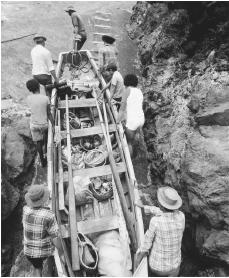
Fishermen haul a boat onto one of Reunion's rocky beach heads.
and that where the cultural models of the larger society are dominant.
Higher Education. In 1954, fifty-seven percent of the population was illiterate, but today the rate is less than 10 percent. Education is valued in families of Tamil, Gujarati, and Chinese ancestry. For the lower and middle classes, school is a democratic institution that allows one to achieve a better future. Pupils with African and mixed origin who frequently grow up in a family with a single mother, often experience failure at school. In contrast, education is particularly valued in families of Tamil, Gujarati, and Chinese ancestry. For the lower and middle classes, school is a democratic institution that allows one to achieve a better future. There are seven thousand students at the ever-expanding University of La Réunion.
Religion
Religious Beliefs. The dominant religion is Roman Catholicism, totaling eighty-six percent of the population. Christianity was established by the first settlers. Although indentured contracts specified that a laborer's religion be respected, the Catholic Church and the authoritarian administration attempted to convert newcomers. Tamils were obliged
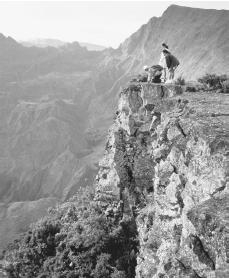
Hikers gaze on the beauty of Cirque de Malfate from the peak of Piton Meido on Reunion Island.
to go to church, wear French clothes, and give Christian names to their children. Contract workers had to express Christian attitudes and practice Christian rites to be accepted by their employers and the larger society. In the eighteenth century, Catholic priests attempted to prevent the construction of Hindu temples and the public practice of Hinduism. When it was finally authorized, the priests continued to spread a negative perception of the Hindu religion as "pagan."
Religious Practitioners. Although they have been largely christianized, people of Indian origin refer to Hindu Gods in important matters. While it has been adapted to a new social context, folk Hinduism has been maintained almost as it was in India at the time of emigration more than one century ago. Among the expressions of this religion are fire walking, animal sacrifices, and rituals of possession by a deity or ancestor. This Hinduism is strongly connected with the idea of protection against bad luck, the evil eye, and the negative forces of the visible and invisible world.
Medicine and Health Care
In rural areas, modern medicine is complemented by traditional local practices based on a mixture of different beliefs (Hindus, Christian, and Malagasy).
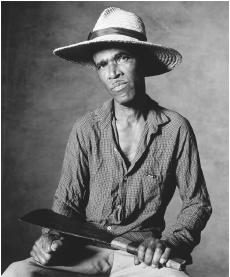
A worker at a sugar processing factory.
Many people consult devineurs who can predict the future and give advice about their problems.
Secular Celebrations
The major holidays are the same as those in France (National Day, Bastille Day, Christmas, New Year's Eve), supplemented by local celebrations such as the anniversary of the abolition of slavery on 21 December and the Tamil and Chinese new years.
The Arts and Humanities
Literature. A local literature that has existed for the last twenty years celebrates the culture of Reunion. Most writers who use the Creole language emphasize a global identity (that of being réunionnais and neglect the cultural heterogeneity of the population.
The State of the Physical and Social Sciences
In the 1970s a local university was created, and French scholars received funding to conduct research on the island. Numerous studies, focused primarily on the Creole language and culture, have since been published. Undertaken by researchers or students from mainland France or natives of the island, they mostly see the society as an integrated unit or a place of culturally distinct subcultures. An outward perspective—still awaited—should allow a better analytic distanciation.
Bibliography
Ghasarian, Christian. Honneur, Chance et Destin: La Culture Indienne à LaRéunion, 1991.
——. "Interpreting a Hindu Rite: A Critique of a Psychoanalytic Reading." Berkeley Journal of Asian Studies 7: 79–, 1996.
——. "We Have the Best Gods! The Encounter between Hinduism and Christianity in La Réunion." Journal of Asian and African Studies 23 (3–4): 286–295, 1996.
——. "Language Strategies in La Réunion." Cahiers 4(3): 7–18, University of Hull, England, 1998.
——. "Patrimoine et Ethnicité à LaRéunion: Dynamiques et Dialogismes." Ethnologie Francaise , 3: 365–374, 1999.
Leguen, M. Histoire de l'île de La Réunion, L'Hartmattan , 1979.
